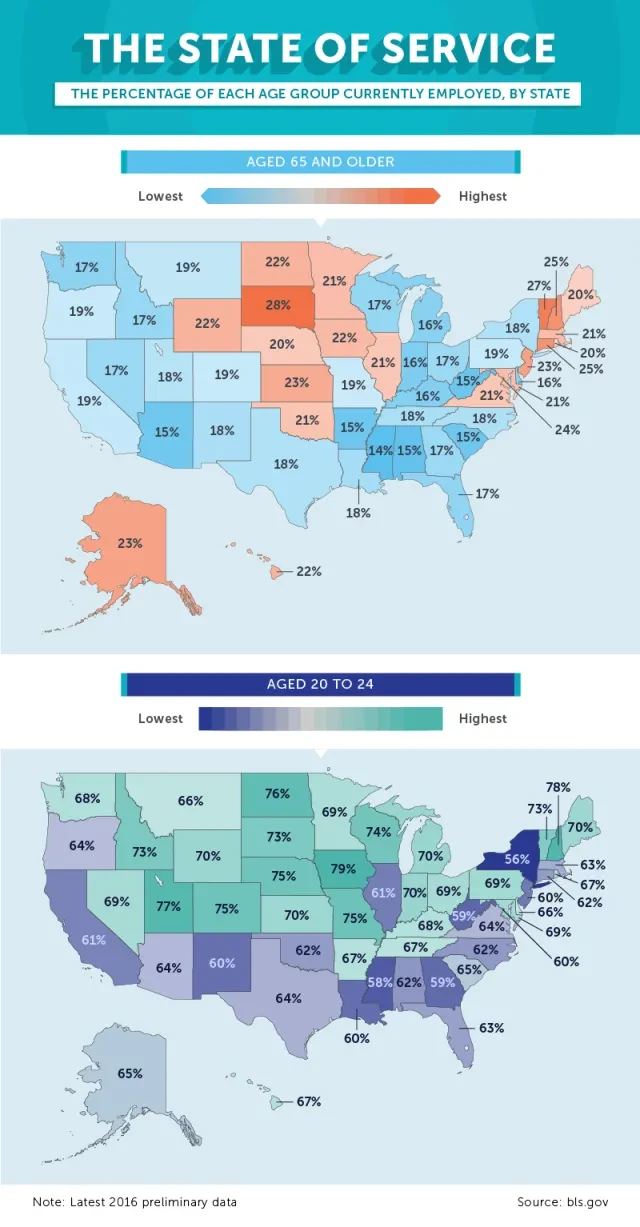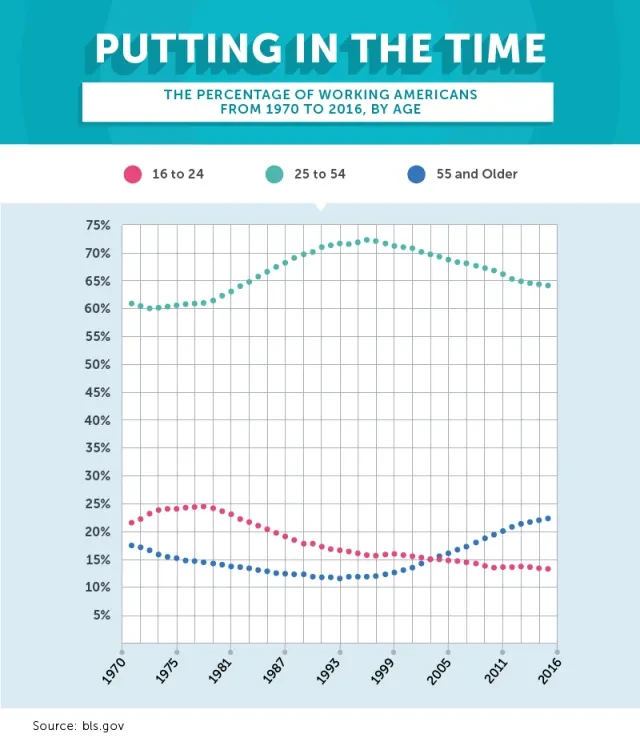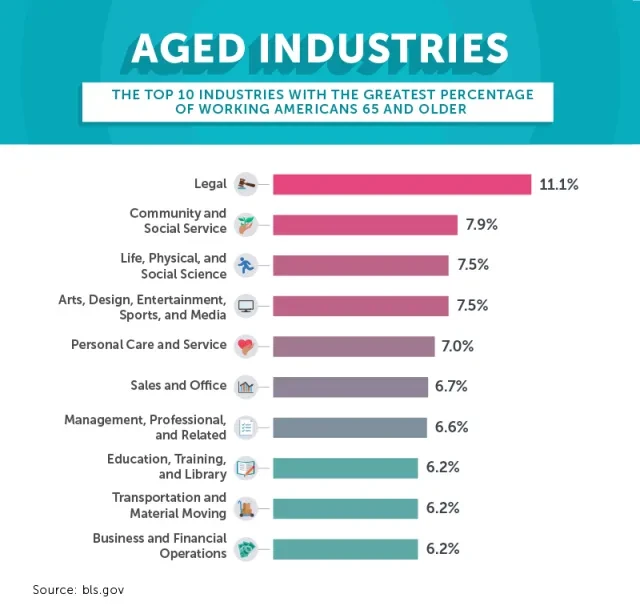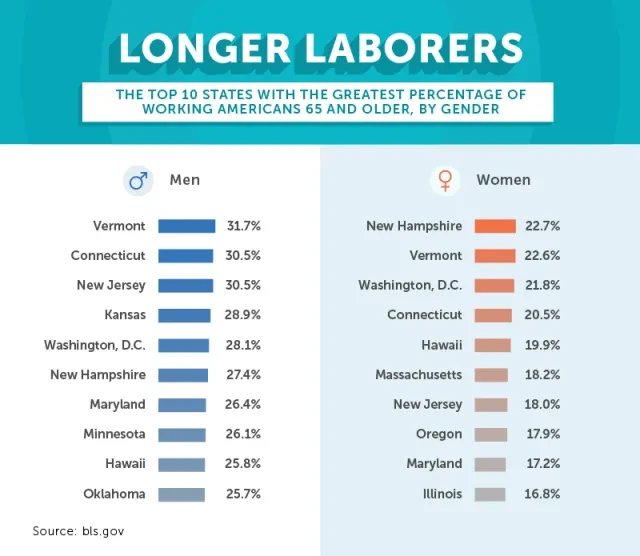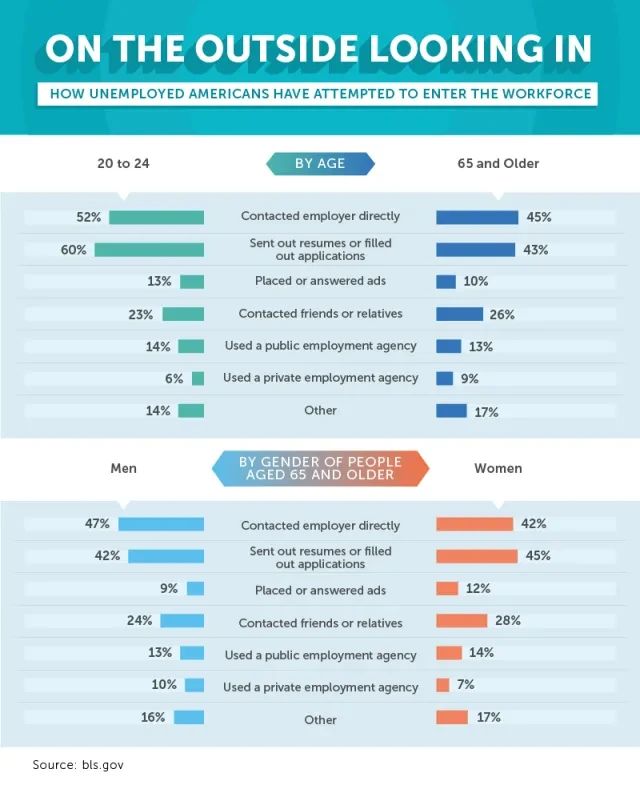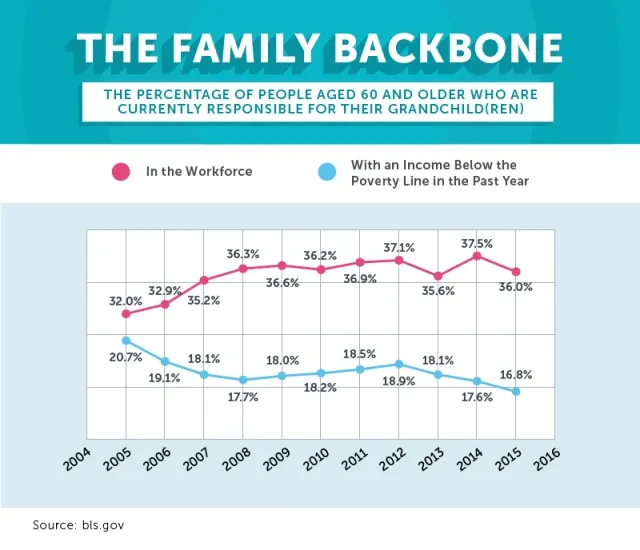Working Late in Life: A Look at Employment Ages in the U.S.
- Beneficios para empleados
- Artículo
-
Lectura de 6 minutos
-
Last Updated: 12/11/2017

Table of Contents
You’ve probably heard a lot about millennials in the American workforce today. They now make up the largest percentage of the working population and are often cited as being a force of change in the shifting professional landscape. In truth, the average employee in the U.S. workforce is actually getting older and, by 2024, it may be completely dominated by older generations.
This means the average American is putting off retirement and working longer than those in previous generations. Either out of necessity or preference, more than a third of Americans don’t expect to retire when they turn 65, and some of the youngest Americans today don’t expect to retire at all.
To understand the impact older employees are having on the workforce, we used official data from the Bureau of Labor Statistics (BLS) to determine which states have the greatest percentage of working Americans over age 65, which industries they’re impacting, and how those numbers are continuing to change. Read on to see what we discovered.
Regional Demographics in the Workforce
Our research revealed that the largest concentrations of Americans in the workforce over the age of 65 were primarily located in two regions: the Midwest and Northeast.
With 28 percent of Americans 65 and older currently employed in South Dakota and more than 1 in 5 in Wyoming and Iowa also working, older Americans in the workforce may be more prevalent in states where blue-collar jobs are the most popular. Including careers like food service, electrical work, and mechanical operations, blue-collar work may offer adequate pay, but can also include physical stress.
Utah experienced the best year-over-year job growth compared to any state in the country between 2016 and 2017, with an emphasis on jobs in service and construction.
The Changing Tide
There’s no question that Americans between the ages of 25 and 54 make up the vast majority of the U.S. working economy – though their numbers have been declining while the percentage of older working Americans has continued to grow.
There are many reasons why employers may be looking for older talent today in lieu of younger working Americans. While some industries (including technology) may prefer skills to experience, employers looking to solve talent issues quickly may look to hire Americans with more time in the field or established working histories. Not needing to spend as much time training or getting acclimated to a role could also help save businesses money compared to new, less experienced hires.
In contrast, the percentage of the youngest working Americans, aged 16 to 24, continues to decline. One reason why may be that getting a job immediately after graduation is more difficult, which may point to why the average college student typically spends more than four years in school, delaying their entry into the working population.
Jobs Held by Older Americans
According to the BLS, Americans over 65 can be found in a variety of professional settings, including sales, management, and education. But which industries are they having the biggest impact on today?
Across the country, law school attendance is shrinking. In 2018, the first ever accredited law school in the U.S., Whittier College, will close for good, marking an increasing trend in the reduction of both law school graduates and jobs in the legal field. While that may be bad news for younger Americans looking to pursue law in the future, it may be working out for older Americans. More than 1 in 10 people employed in the legal profession today are 65 and older, the highest percentage of any industry in the country.
Along with legal services, nearly 8 percent of Americans working in social services, physical and social sciences, as well as arts, entertainment, and sports are over the age of 65.
The Gender Gap
Across the U.S., Vermont had the highest percentage of men over 65 in the workforce and nearly the highest percentage of women – men over 65 made up nearly 32 percent of the working population, while women of the same age accounted for close to 23 percent.
Research has shown that while the overall percentage of working Americans over 65 has increased in recent years, women over the age of 50 have found it statistically harder to find employment since 2008. Older working women may have more experience gaps on their resumes as a result of child rearing or time spent at home – and unlike their male counterparts, women over 55 who become unemployed find it far harder to re-enter the workforce and often are more likely to leave it altogether. The decrease in opportunity in certain industries nationwide (including public teaching) also disproportionately affects older women who may be looking for employment.
Across the country, men over 65 occupied more than 1 in 4 jobs in over 10 states, while women over 65 failed to reach 25 percent of the workforce in any state. Connecticut, Hawaii, New Jersey, Washington, D.C., and Maryland were also popular states for both men and women employed past the typical retirement age in America.
Finding New Opportunities
Social media is changing just about everything today, including the talent recruitment process. The rise of online resources, particularly LinkedIn, is having a profound effect on the way employers seek out – and scout – their next employees.
Younger unemployed Americans (those aged 20 to 24) were more confident reaching out to an employer directly for a job opportunity than those 65 and older. Confidence isn’t just important for getting hired – it can also be a sign of a more successful track record, including increased productivity and better employee relations. Younger Americans told us they typically sent out their resumes or answered ads for job opportunities, while older Americans seemed to prefer networking with friends and family or utilizing a private employment agency to find work.
Unemployed men 65 and older were also more likely to contact an employer directly, while women from this demographic were more inclined to send out resumes, utilize ads or a public employment agency, and network with their friends and family.
Breadwinners
According to census data, 2.7 million grandparents around the country act as primary caregivers (or parents again) for their grandchildren. Nationwide, this number has been on the rise and is expected to continue climbing.
In 2015, 36 percent of working Americans 60 and older were financially responsible for their grandchildren. A decade before, only about 33 percent of working Americans were in a similar position. For older Americans financially supporting their grandchildren, the average financial position has improved since 2005 as more have forgone retirement to return or stay employed in the workforce. In 2005, more than 1 in 5 lived below the poverty line at some point within the past 12 months, while less than 17 percent were living below the poverty line in 2015.
Getting Ahead of the Curve
Regardless of your current age, the reality is that the workforce is changing. As Americans continue to put off retirement, more and more generations are working alongside one another in the workplace. These shifts won’t just have an impact on the hiring process or the competition in the job market, but also on how employees interact with one another and the types of considerations employers need to make when thinking about human resources and employee benefits.
In a constantly evolving workforce, Paychex can solve your changing HR needs, from recruiting and hiring, to retention. Paychex Flex(R), our integrated HCM technology and service platform, combines your HR, payroll, and benefits management to help you make more strategic hiring decisions to meet your company’s vision today and in the future. Visit Paychex.com to learn more.
Methodology
We researched this article in August, 2017 using information from the Bureau of Labor Statistics (BLS) database regarding labor force and unemployment statistics, 2015 to 2016. To calculate the figures in the graphic entitled “Putting in the Time,” we used data from 1970 to 2015. To calculate the figures in the graphic entitled “The Family Backbone,” we used data from 2005 to 2015.
Sources
- https://www.usnews.com/news/articles/2015-12-24/older-workers-to-dominate-labor-market-by-2024
- https://bluecollarjobs.us/2017/04/10/highest-to-lowest-share-of-blue-collar-jobs-by-state/
- https://www.cnbc.com/2017/07/11/top-states-to-find-a-job-in-america-in-2017.html
- https://money.usnews.com/money/retirement/articles/2015/09/18/5-reasons-employers-should-hire-more-workers-over-age-50
- https://www.nytimes.com/2017/06/28/technology/tech-jobs-skills-college-degree.html?mcubz=3&mtrref=www.google.com
- https://www.usatoday.com/story/college/2015/12/16/breaking-the-4-year-myth-why-students-are-taking-longer-to-graduate/37409747/
- https://www.usatoday.com/story/news/2017/06/28/law-schools-hunkering-down-enrollment-slips/430213001/
- https://www.pbs.org/newshour/economy/women-over-50-face-cant-find-jobs
- https://www.nytimes.com/2016/01/02/business/economy/over-50-female-and-jobless-even-as-others-return-to-work.html?mcubz=3&mtrref=www.google.com&mtrref=undefined&gwh=583ADB0E51394AFEF0DD56DA47CEAAEE&gwt=pay
- https://business.linkedin.com/talent-solutions/blog/future-of-recruiting/2017/how-recruiting-and-hr-will-change-in-2017-according-to-linkedins-talent-leaders
- https://www.peatworks.org/blog/2016/may/how-social-media-changing-talent-recruiting
- https://smallbusiness.chron.com/impact-confidence-work-performance-24235.html
- https://www.pbs.org/newshour/nation/more-grandparents-raising-their-grandchildren
- http://www.businessinsider.com/first-fully-accredited-law-school-closing-2017-4
Fair Use Statement
Do you want to share what you just learned about the labor force and its relation to people aged 65 and older? We grant permission to use any of the images, facts, and text above for noncommercial purposes. We only ask that you cite the author and link back to this page when you share.
Tags

